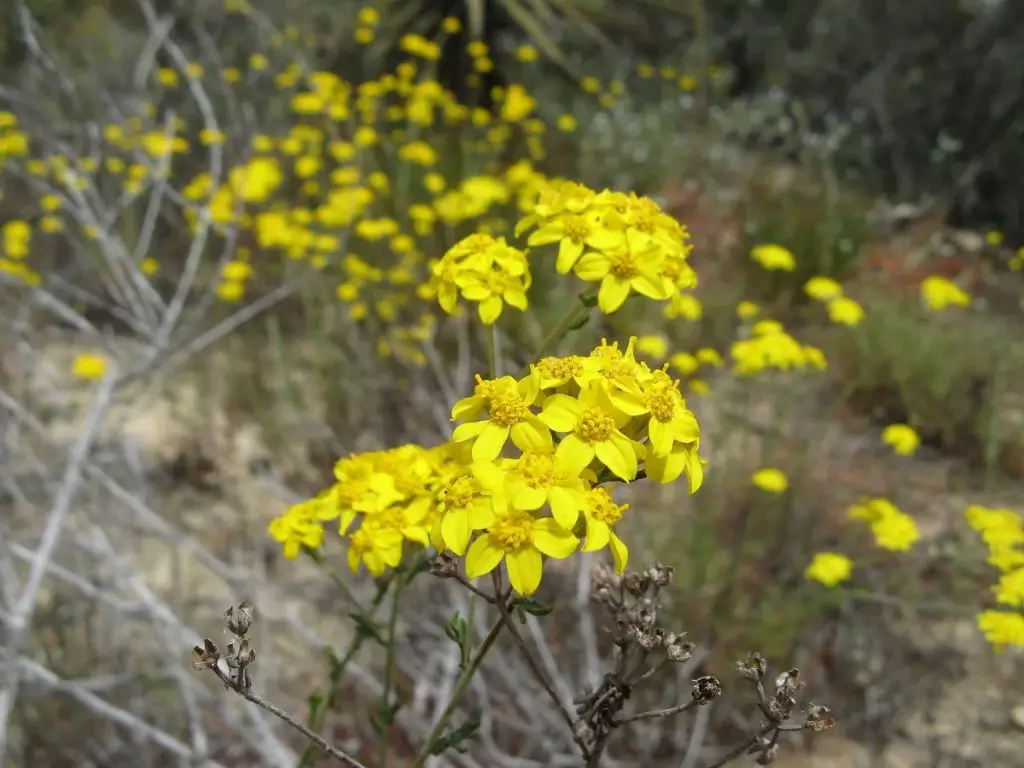Is Golden Yarrow Native To California?
Introduction
The question of whether Golden Yarrow (Eriophyllum confertiflorum) is native to California is an interesting one for those wanting to cultivate native plants in the state. Golden Yarrow is a flowering perennial shrub found throughout many parts of California, valued for its year-round blooms and uses such as erosion control. Determining if it is endemic or native introduced provides insight into its ecological benefits and appropriate uses. This article will explore the origins of Golden Yarrow and examine evidence of its native status in California.
What is Golden Yarrow?
The scientific name for golden yarrow is Achillea filipendulina. It also goes by common names like fernleaf yarrow and fern-leaf yarrow. Achillea filipendulina is a species of yarrow that is upright and clump-forming, growing to about 3-4 feet tall and 2-3 feet wide. The lacy, finely-divided foliage is bright green and fern-like. The flowers are flat-topped clusters of small yellow florets that bloom throughout the summer. This yarrow species is native to the Caucasus region, Iran, Afghanistan and parts of central Asia. It grows on rocky slopes, meadows and forest margins in its native habitat.
Sources:
https://en.wikipedia.org/wiki/Achillea_filipendulina
https://www.missouribotanicalgarden.org/PlantFinder/PlantFinderDetails.aspx?taxonid=277264
Native Plant Status
What does it mean for a plant species to be considered “native” to California? According to the California Native Plant Society (CNPS), California native plants are those that grew here prior to European contact in the late 18th century. Many native plants evolved alongside and adapted to California’s unique Mediterranean climate and diverse geography over thousands of years. The CNPS defines native plants as those that existed in California “before the arrival of European explorers and colonists.”
Major resources that catalogue California’s rich diversity of native plants include:
- The CNPS’s Manual of California Vegetation, which documents over 4,500 native plant communities
- The Calflora database, which includes over 9,000 plant species native to the state
- The Jepson Manual, considered the definitive California floristic manual
- The California Natural Diversity Database from the Department of Fish and Wildlife
These resources help researchers, government agencies, and conservationists identify and protect California’s diverse native flora. According to the CNPS, over 6,500 vascular plant taxa are native to California.
Golden Yarrow’s Origins
Golden yarrow (Eriophyllum confertiflorum) is considered native to California and the West Coast according to sources like the Nature Collective (https://naturecollective.org/plant-guide/details/golden-yarrow/).
However, its full origins are more complex. According to Wikipedia (https://en.wikipedia.org/wiki/Eriophyllum_confertiflorum), golden yarrow is native to western North America from British Columbia to California to northwestern Mexico. It likely originated in this region and expanded its range naturally over time.

There is some debate as to whether golden yarrow is technically a California native or was introduced. Its wide native range in western North America suggests it may have naturally migrated into California rather than being introduced by humans. However, more research would be needed to conclusively determine if it was present in California prior to European settlement.
Habitat and Growing Conditions
Golden Yarrow thrives in a variety of habitats and growing conditions across California. According to the California Native Plant Society, it grows best in coastal bluff scrub, coastal scrub, foothill woodlands, valley grasslands, and chaparral habitats. Golden Yarrow prefers drier soils and sunlight. It can grow in clay, loam, or sandy soils that are well-drained.
This versatile plant grows at elevations from 0 to 5,600 feet. It is found along the coast and in inland valleys and foothills. Golden Yarrow grows well in USDA hardiness zones 7-10. The climate varies from coastal areas with cool, wet winters and dry summers, to hot, dry inland areas with colder winters. Golden Yarrow is drought tolerant once established and needs little supplemental watering.
Overall, Golden Yarrow can thrive in a range of conditions across California. Its adaptability to different soils, habitats, elevations and climates make it a versatile California native plant.
Evidence in California
Golden Yarrow is considered a California native plant with accounts dating back to the early botanical explorations of the state. Botanist John Thomas Howell, who published an extensive Flora of California in the early 20th century, documented Golden Yarrow growing in coastal regions from Mendocino County south to San Diego County.
Another notable early California botanist, Willis Linn Jepson, recorded observations of Golden Yarrow in the California Academy of Sciences Memoirs in 1925. Jepson wrote that Golden Yarrow was “common on dry hills and valleys, chiefly Coast Ranges from Mendocino County to Santa Barbara County.” He also noted populations in the foothills of the Sierra Nevada mountains.
Today, Golden Yarrow grows wild in many parts of coastal and inland California https://www.muellerlandscapeinc.com/what-it-it-golden-yarrow/. It is often found in chaparral, coastal scrub, valley grassland, and woodland habitats. The herbaceous perennial thrives in dry, well-drained soils and full sun exposure.
The historical accounts combined with modern observations provide strong evidence that Golden Yarrow is native and widespread in California.
Cultivation
Golden Yarrow has a long history of cultivation in California. Native Americans and early European settlers began cultivating it for food, medicine and ornamental uses. By the late 1800s, Golden Yarrow was a sought after garden plant in California. According to Calscape, it was described in cultivation in California as early as 1880.
Today, Golden Yarrow remains a popular ornamental plant for gardens and landscaping in California. It is appreciated for its bright golden yellow flowers that bloom spring through summer. Golden Yarrow works well in wildflower gardens, butterfly gardens, and xeriscaping. It is drought tolerant once established. The San Diego Seed Company recommends it as an easy to grow plant that attracts pollinators. Golden Yarrow can spread by rhizomes to form an attractive ground cover. It mixes well with other native plants like California Poppy and Lupine.
There are cultivated varieties of Golden Yarrow as well. Little Moonshine Yarrow is a dwarf, compact cultivar that grows 12-18 inches tall. It was bred for superior performance in gardens. Gardeners should take care that cultivated varieties don’t spread and naturalize, potentially impacting native populations.
Ecological Value
Golden yarrow plays an important role in local ecosystems in California and other western states where it is native. As a flowering plant, it provides nectar and pollen that attract and support native pollinators like bees, butterflies, flies, and beetles (Watershed Nursery). The caterpillars of some Lepidoptera species also feed on the foliage and flowers. Birds will occasionally eat the seeds as well.
Golden yarrow’s deep roots help stabilize soils and prevent erosion on slopes and other open areas. The plant also accumulates minerals from the soil which are returned to the surface when the leaves drop. This slow cycling of nutrients benefits surrounding plants and soil health (Mueller Landscape Inc.). As a drought-tolerant plant, golden yarrow provides good groundcover that requires minimal water once established.
Overall, golden yarrow is considered a valuable plant for supporting wildlife, helping conserve water usage in landscaping, controlling erosion, and promoting healthy soil and plant communities.
Uses for Humans
Golden Yarrow has a long history of traditional uses, especially by Native American tribes in California and the Southwest. The Cahuilla used Golden Yarrow as a poultice for wounds, burns, and insect bites. The plant material was soaked in water and applied to the affected area. The Pima utilized Golden Yarrow as a cold infusion or tea to relieve stomach aches and cramps. The leaves and flowers were also chewed by the Diegueño for toothache pain.
Today, Golden Yarrow remains valued for its medicinal properties. The leaves and flowers can be made into a tea or tincture that is used to treat fever, flu, colds, allergies, and digestive issues. According to Drugs.com, Golden Yarrow contains flavonoids that have anti-inflammatory effects https://www.drugs.com/npc/yarrow.html. The tea is mildly bitter with an aromatic, astringent flavor. Some herbalists recommend Golden Yarrow tea to help reduce menstrual cramps. The flowers and leaves are also edible and can be used as a seasoning or garnish in soups, salads, and other dishes.
Conclusion
Based on the evidence presented, it is clear that Golden Yarrow is not considered a native plant species in California. While it can be found growing wild in some parts of the state, research indicates Golden Yarrow originated in the Mediterranean region and was introduced to North America by European settlers. Its ability to adapt to the climates and soils of California has allowed it to naturalize in certain areas over time, but this alone does not confer native status.
The key defining characteristics of native plants are that they occurred in their habitat prior to European contact and colonization beginning in the late 18th century. Golden Yarrow does not meet this criterion, as all available records point to it being brought to California long after this period. Additionally, there is an absence of references to Golden Yarrow in writings or ethnobotanical sources on California’s indigenous flora prior to European settlement.
While Golden Yarrow grows well in many parts of California and provides ecological and ornamental value, the evidence firmly demonstrates that it should be considered a non-native, naturalized species. Careful research into a plant’s origins and history in an area are required to determine native status, rather than observances of where it currently grows. The conclusion on Golden Yarrow is clear – it is not endemic to California.




